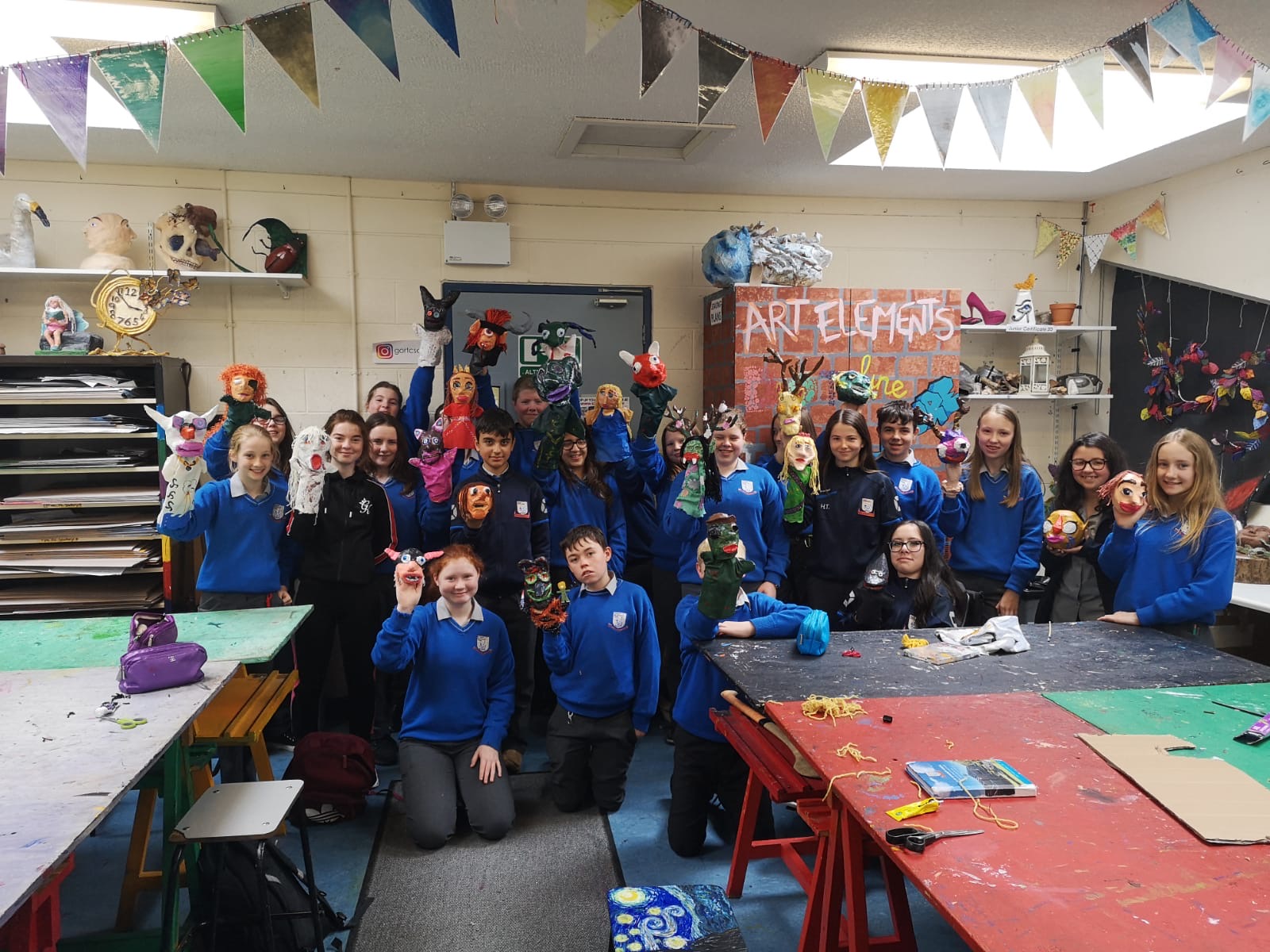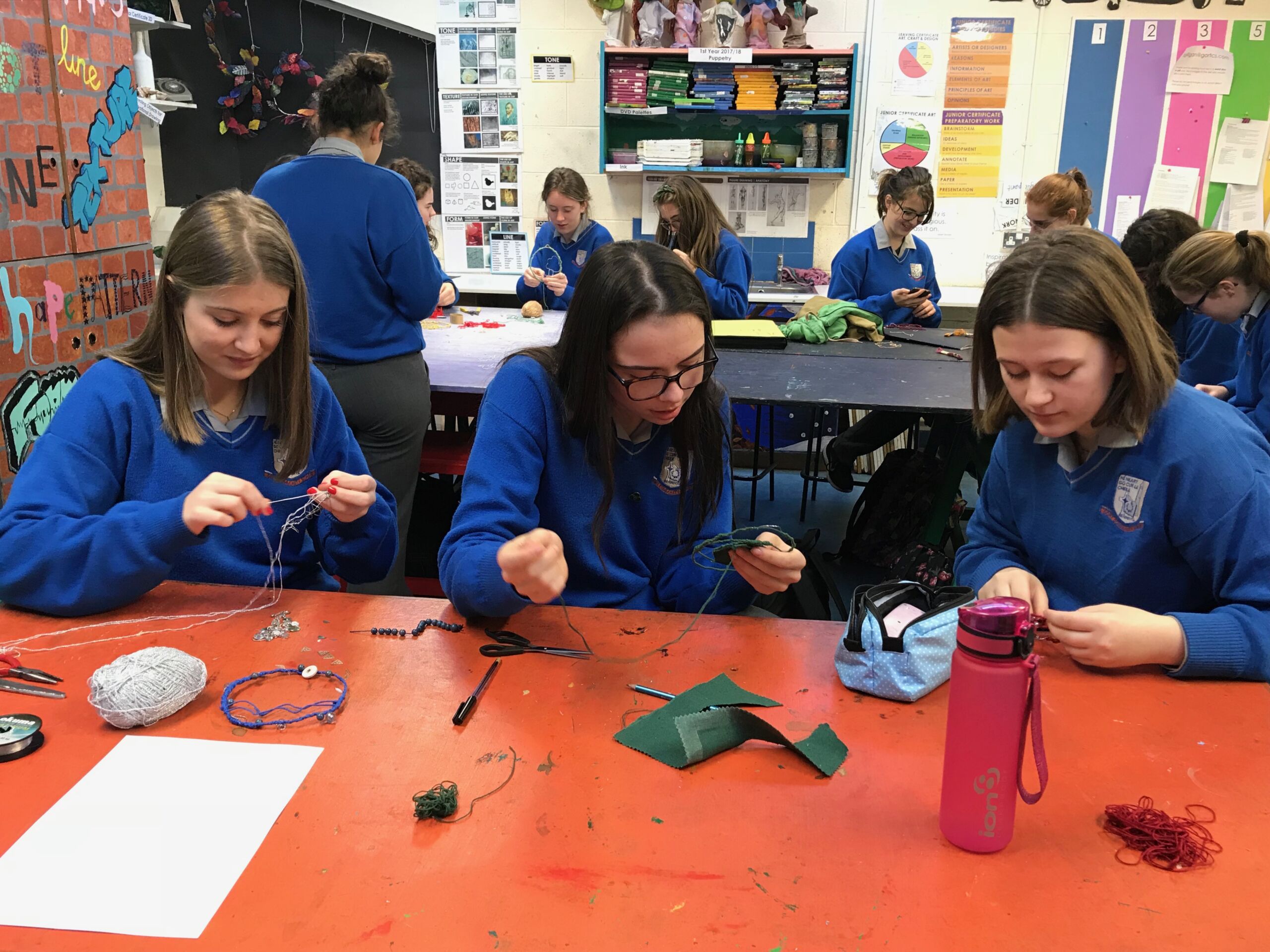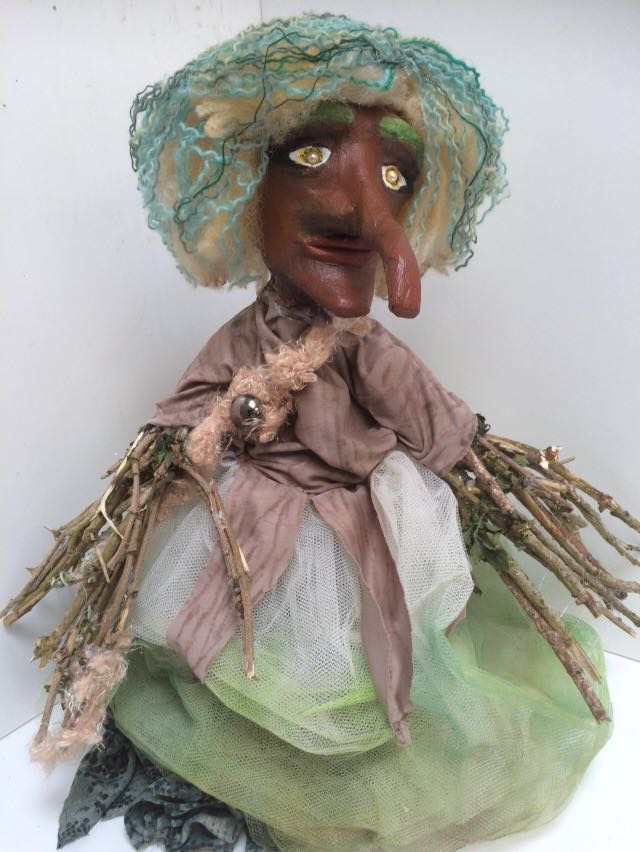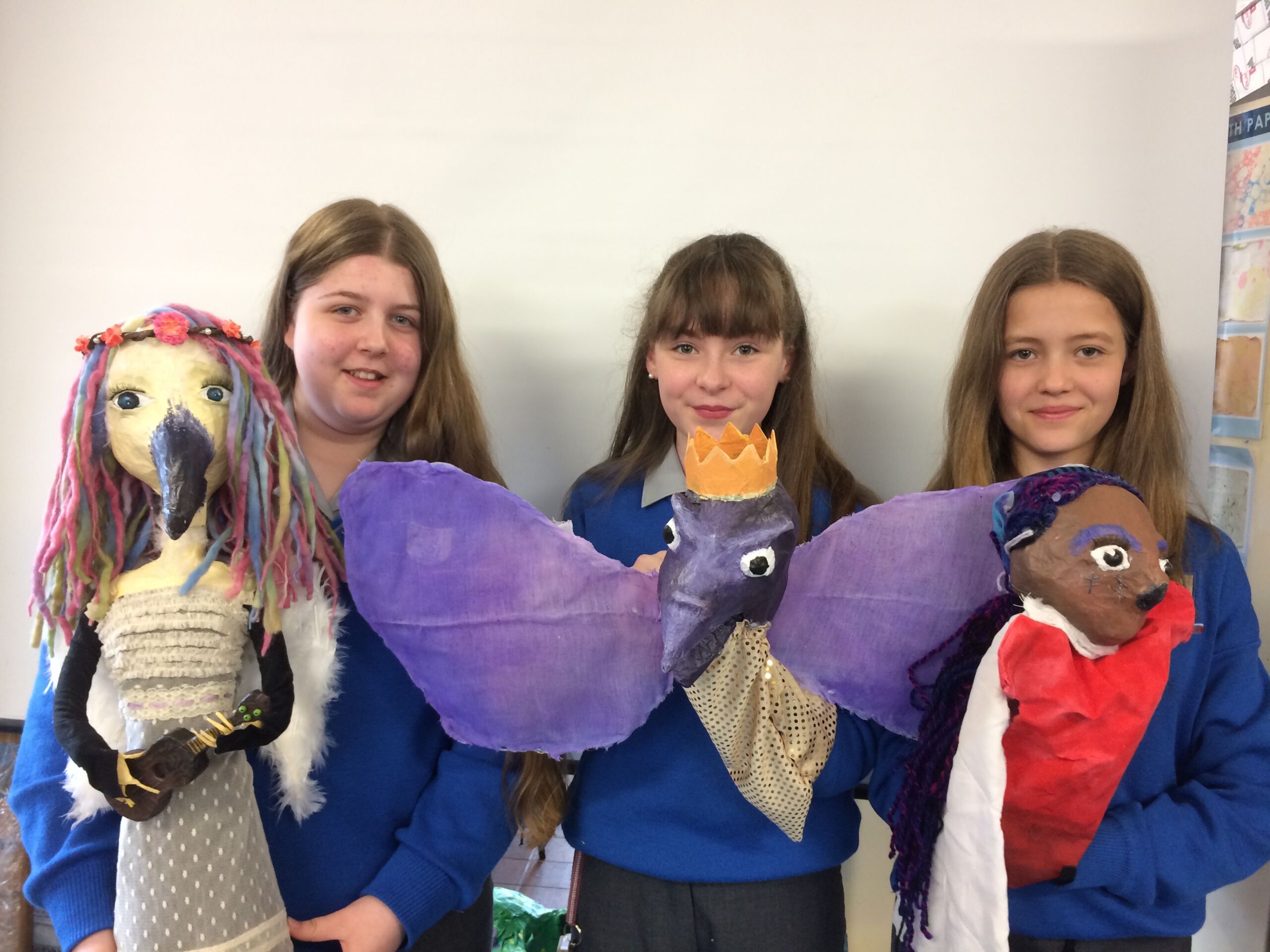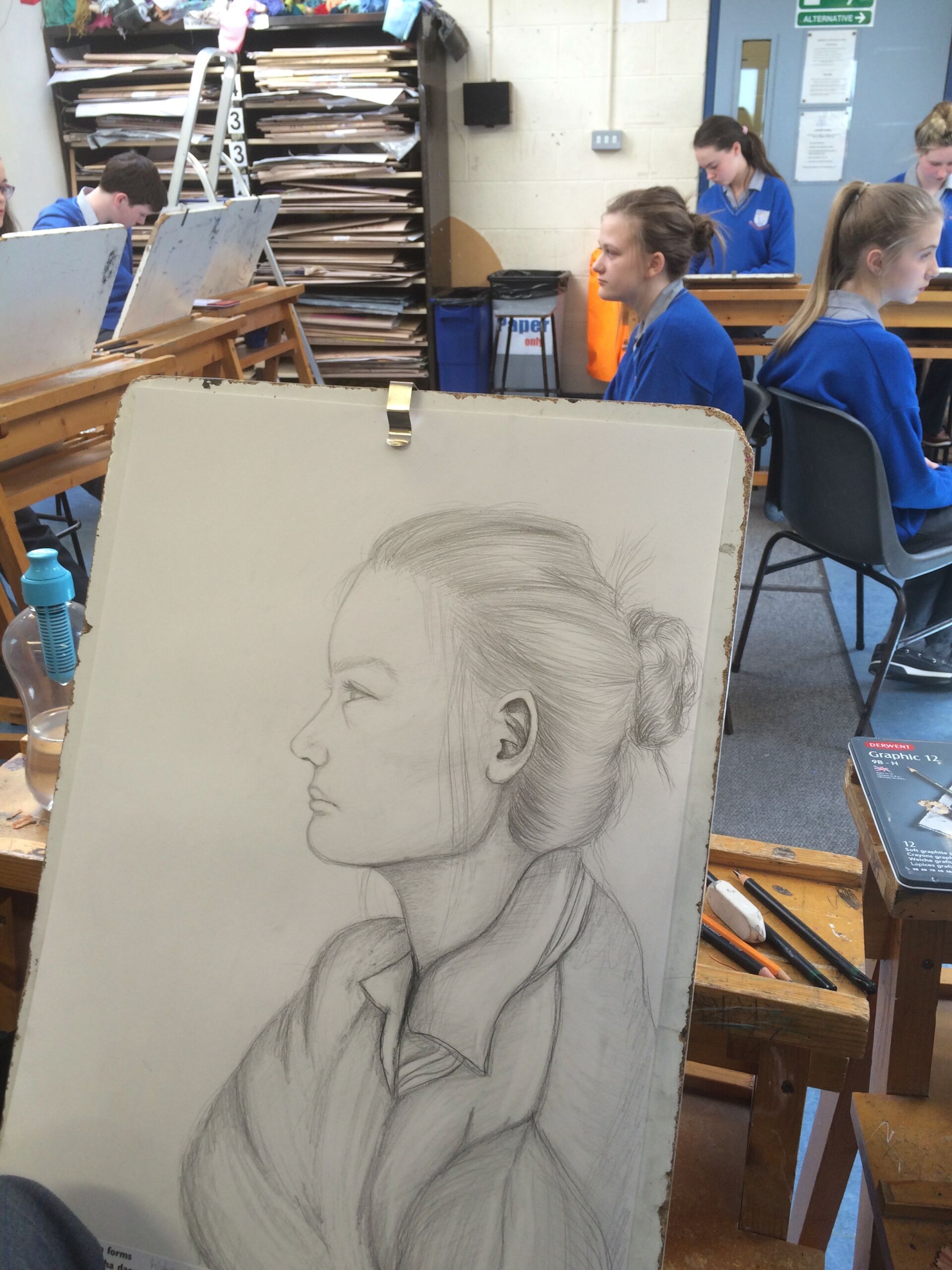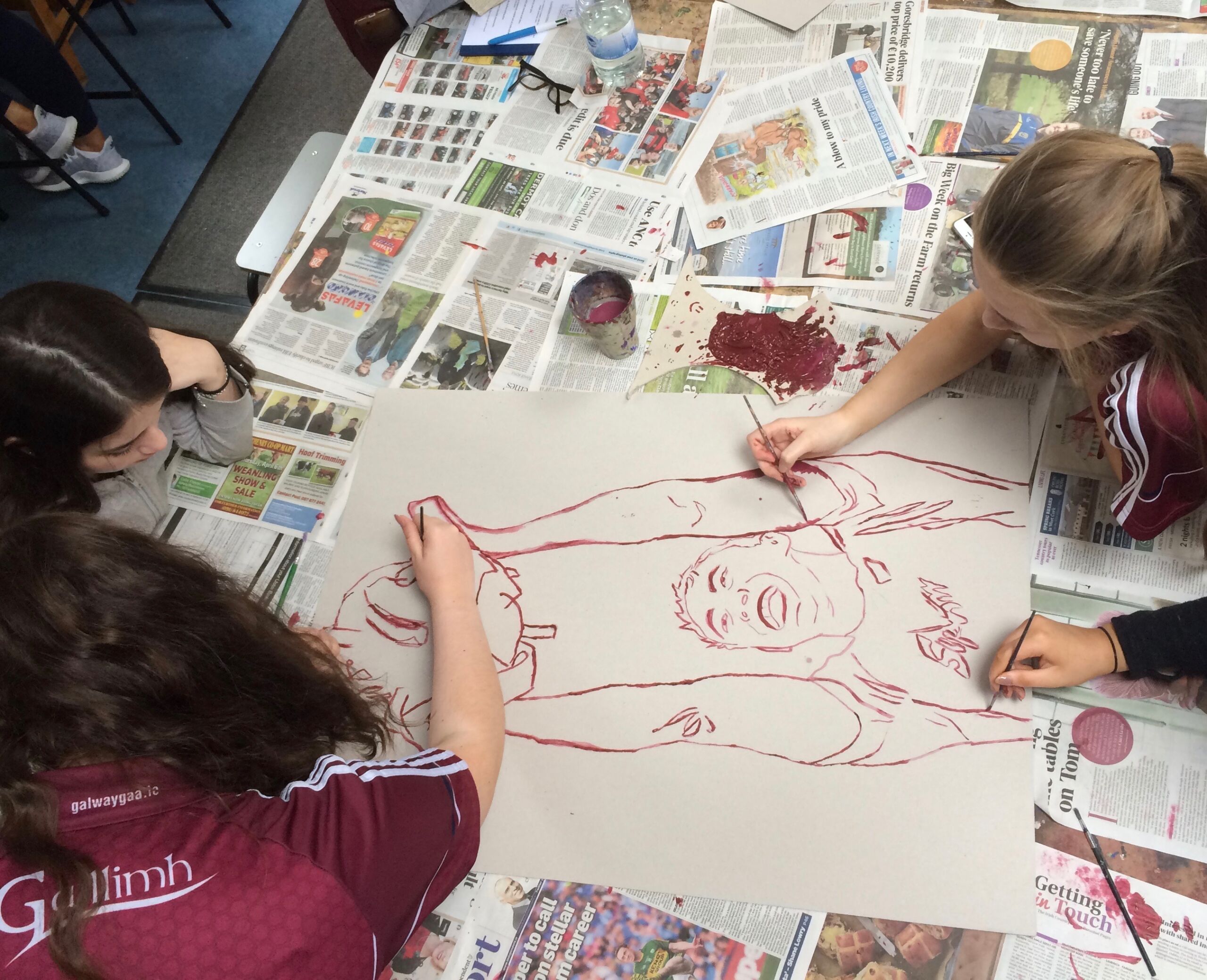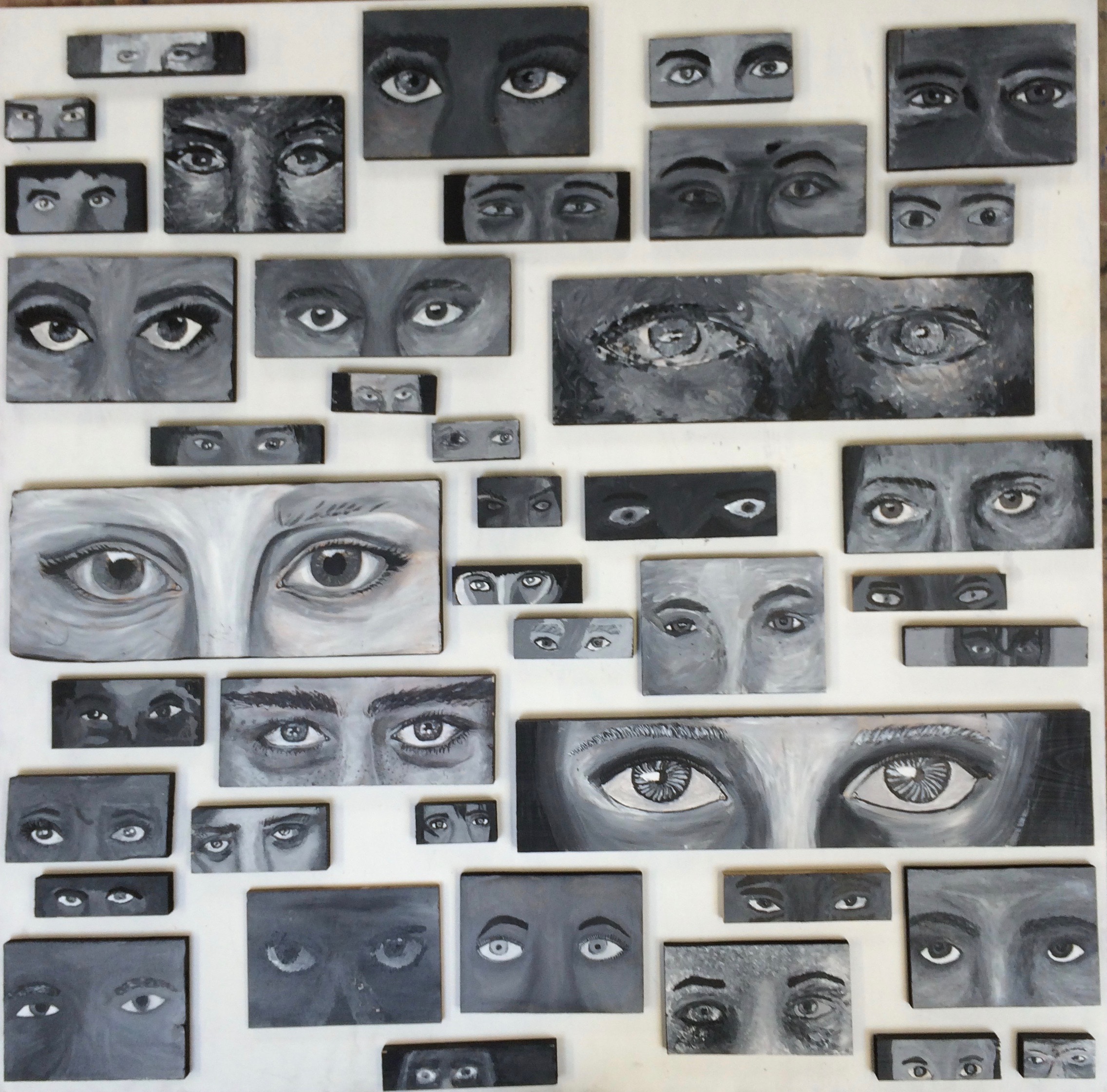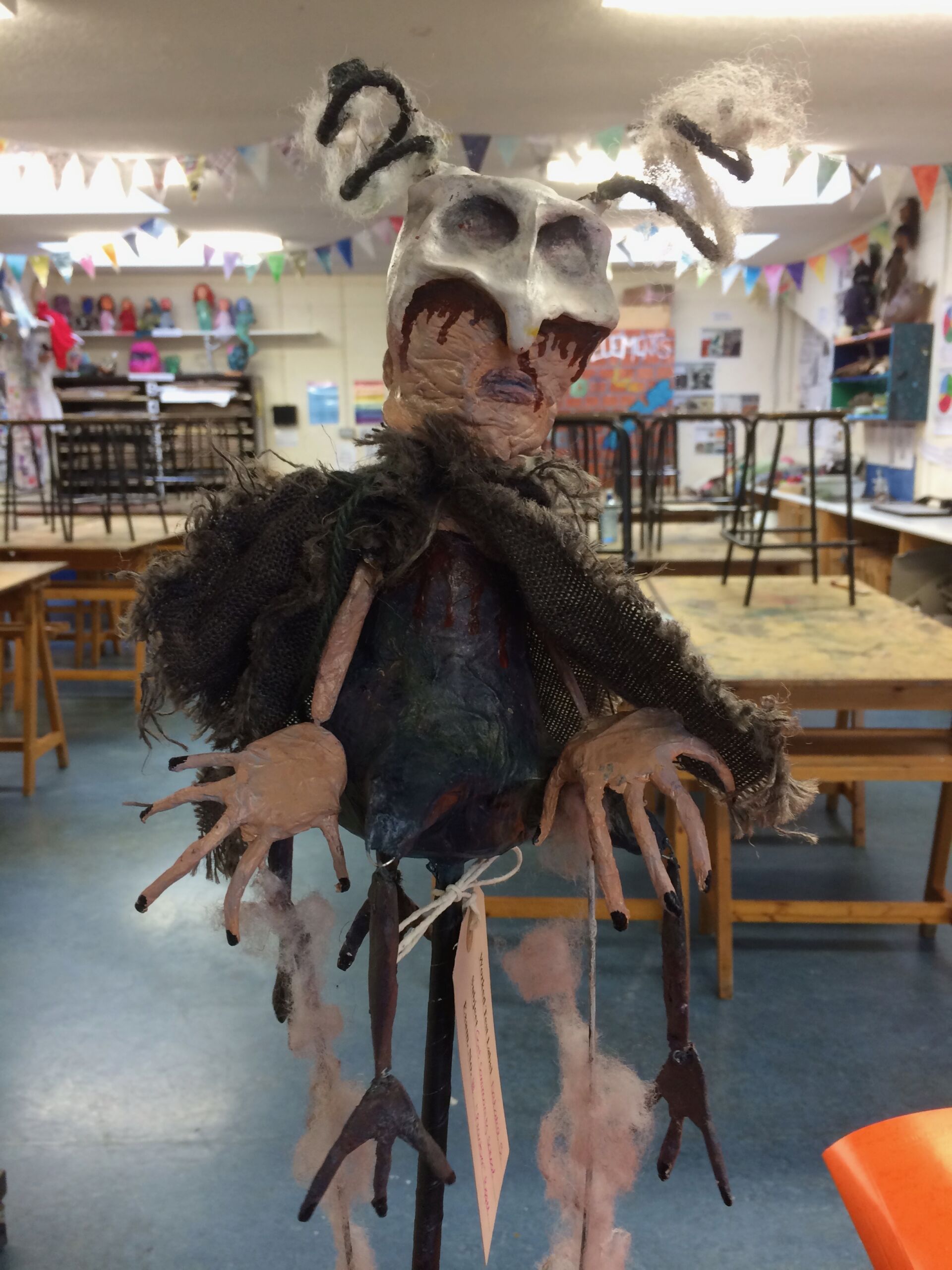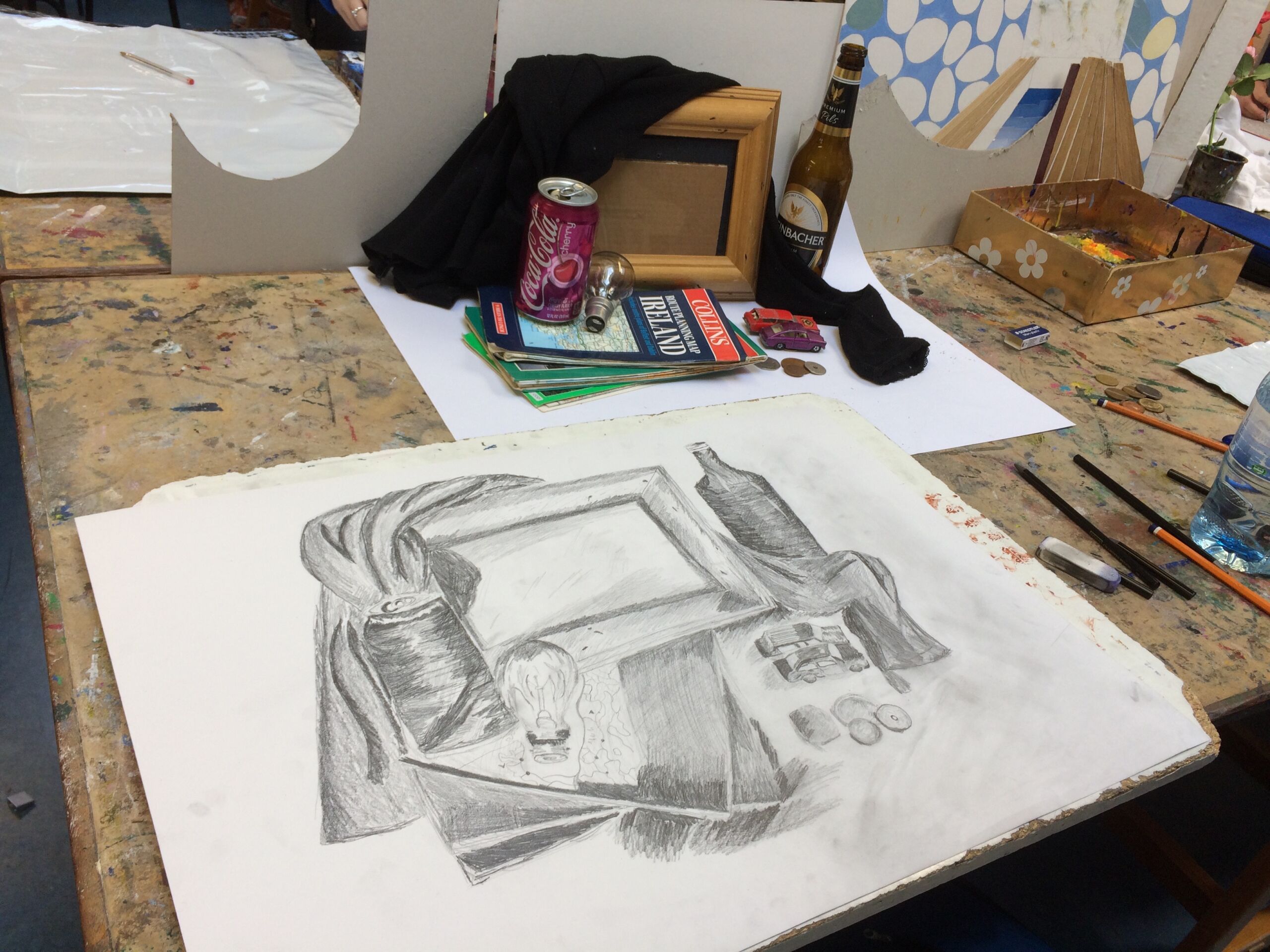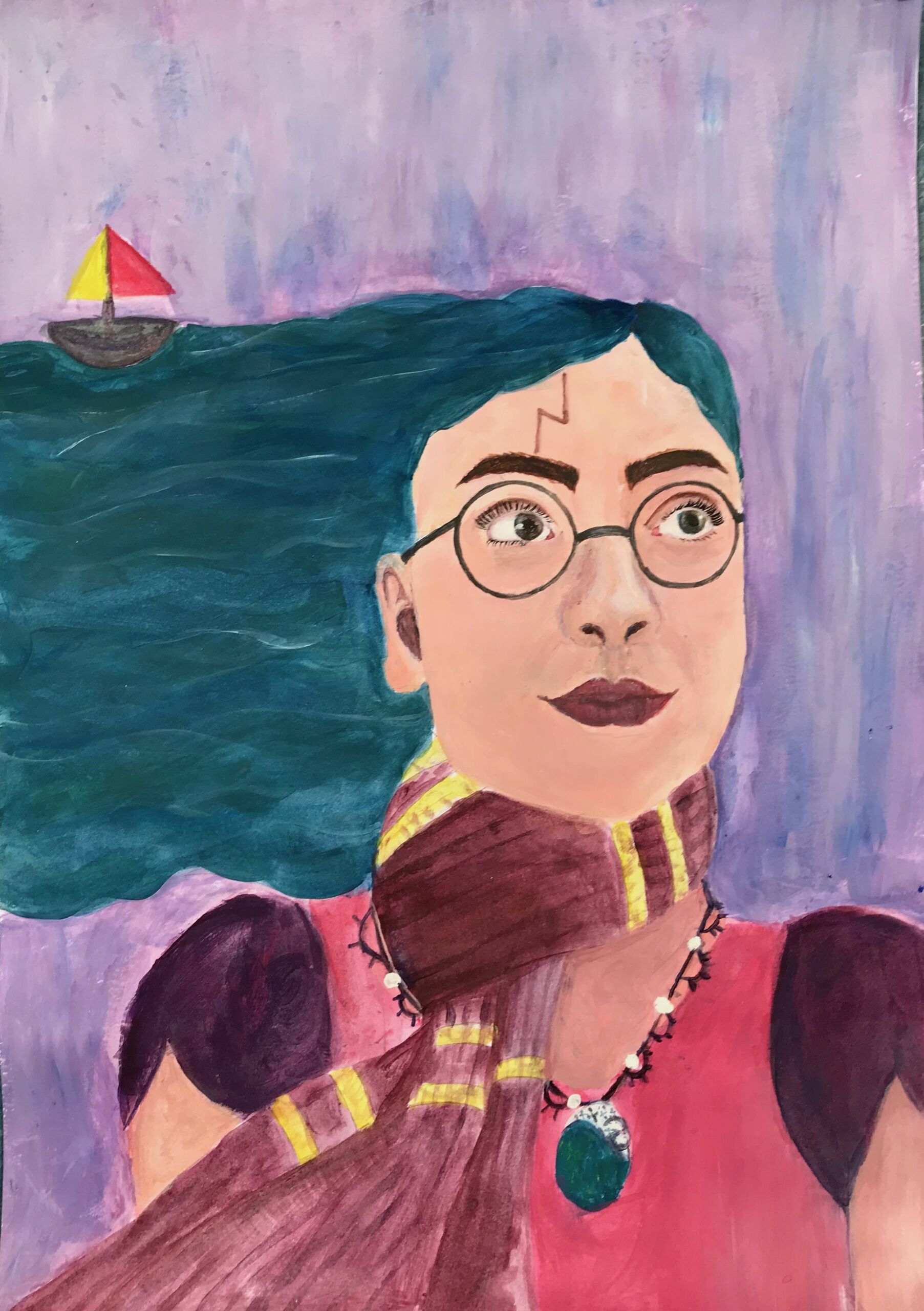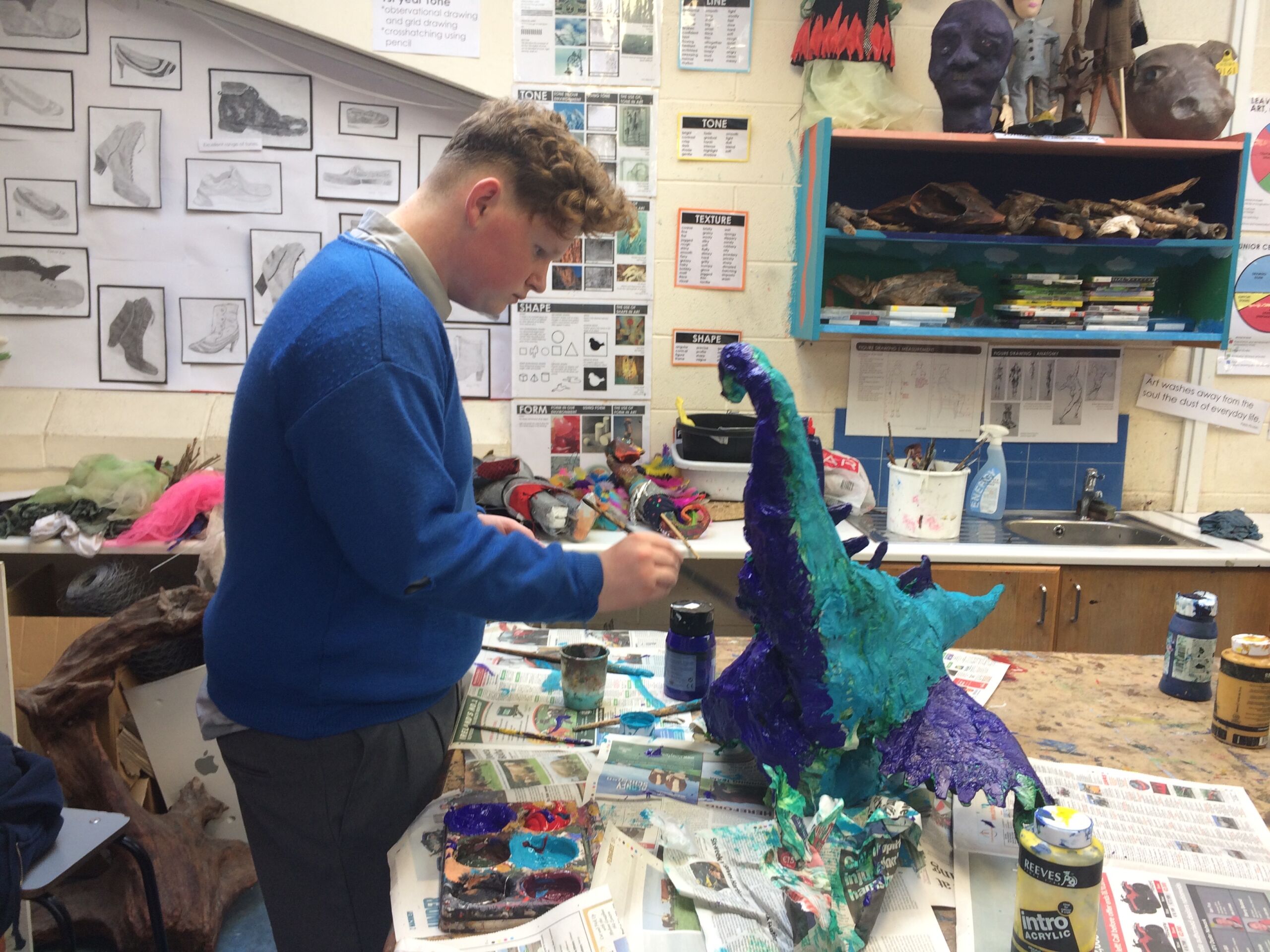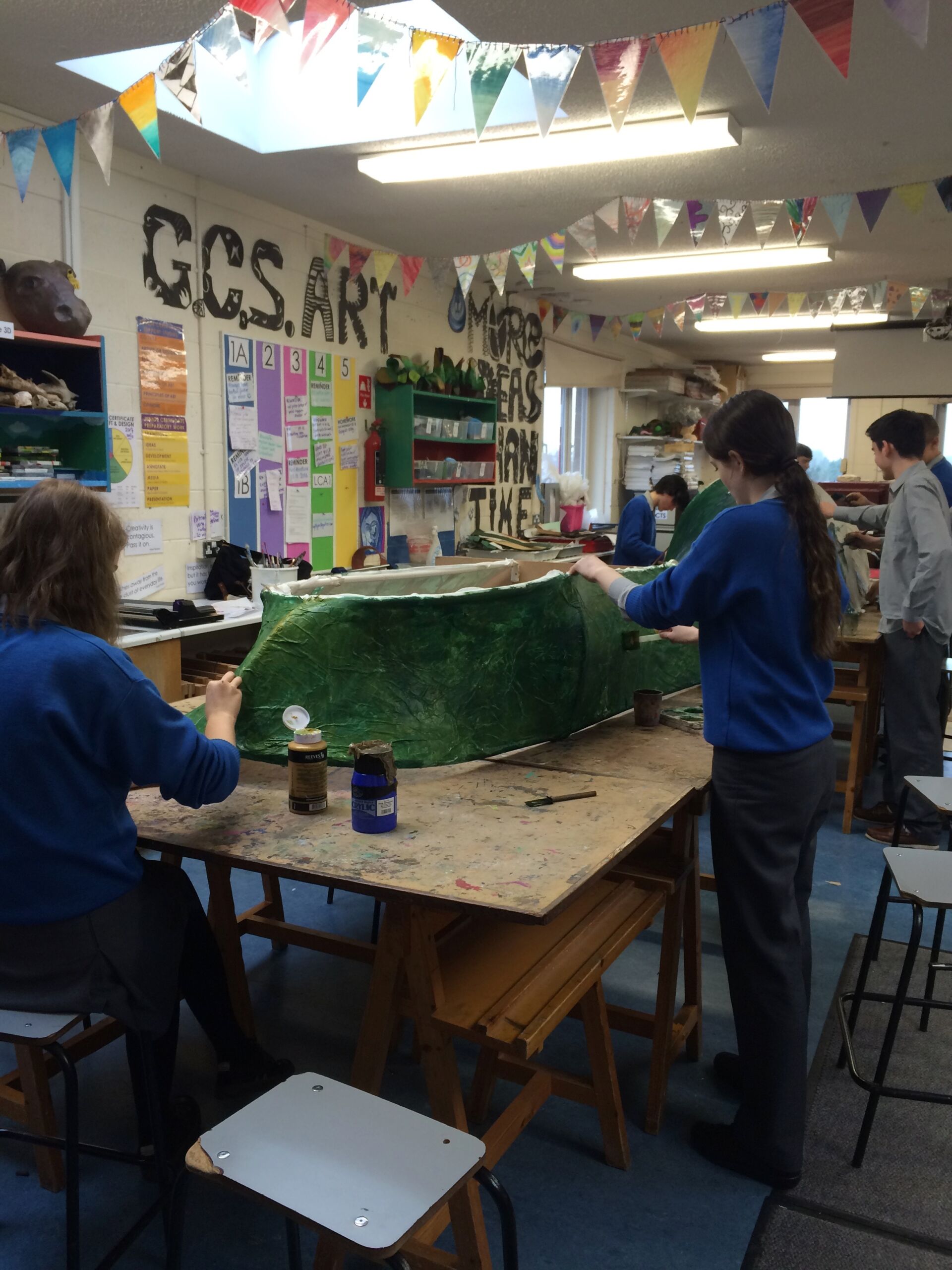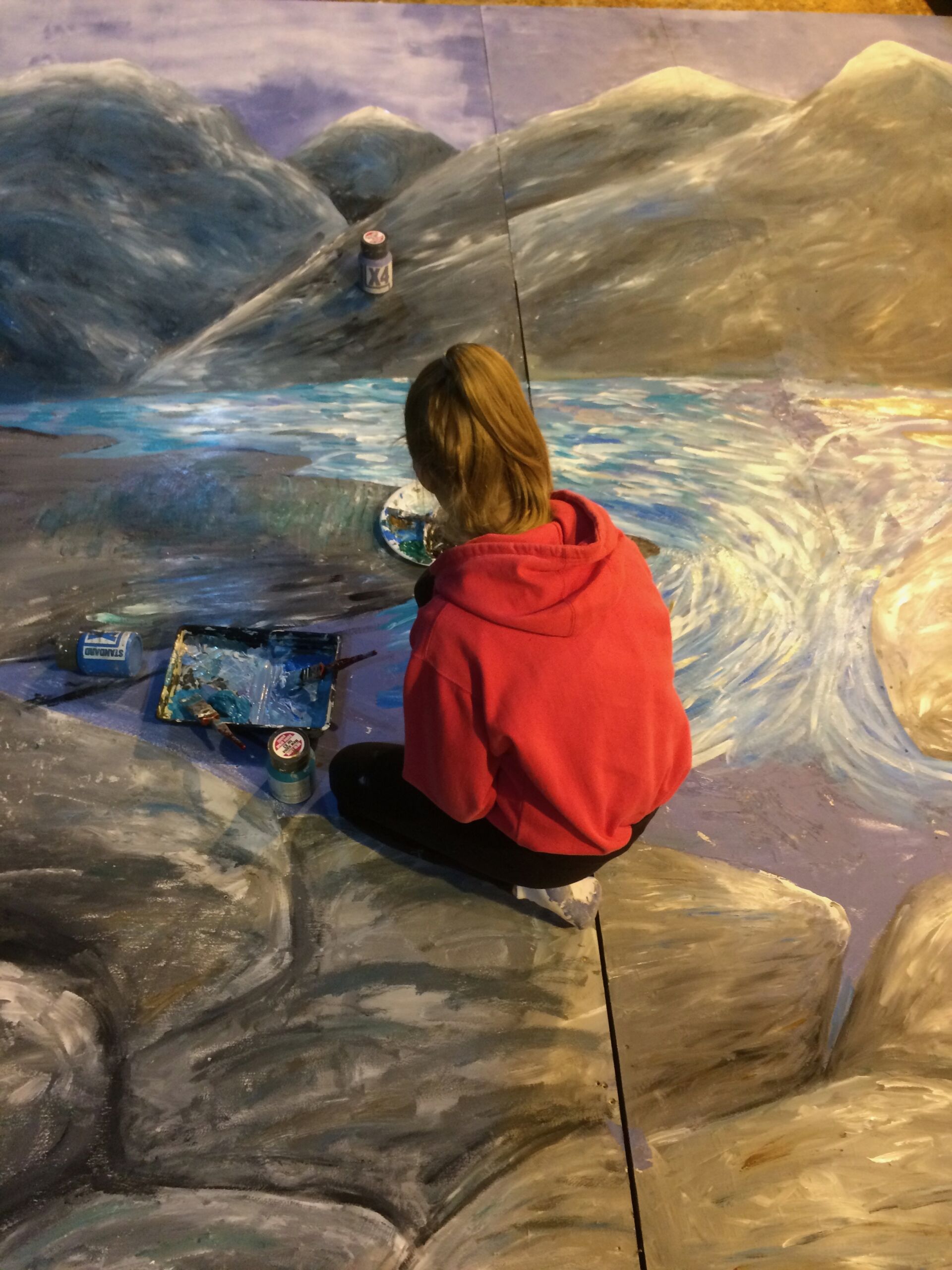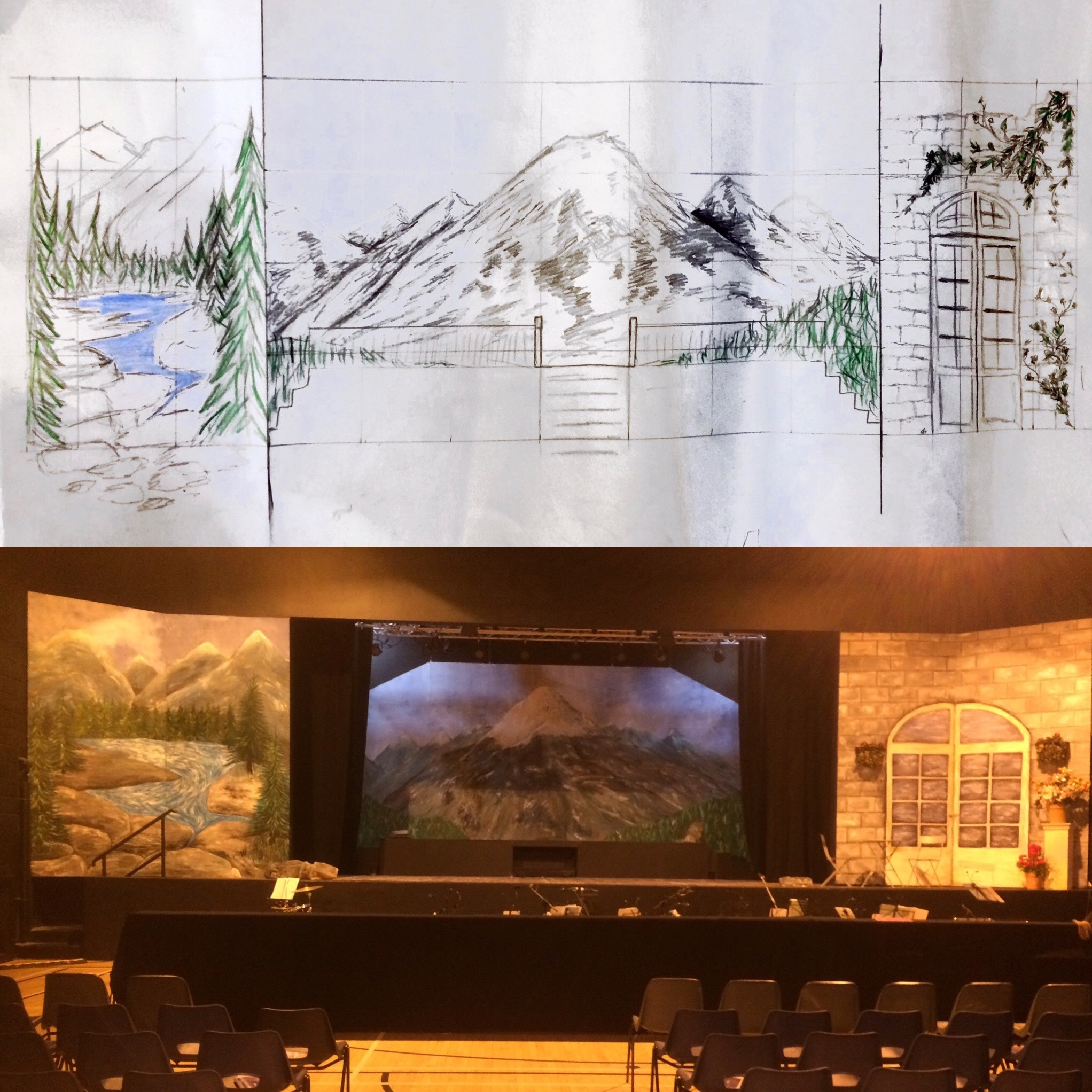JUNIOR CYCLE VISUAL ART
Visual Art is a subject that promotes teaching and learning through art, craft and design. This involves becoming familiar with and applying the elements of art and principles of design, and the knowledge and skills associated with these processes, their histories and their contemporary practices.
Visual Art also recognises and rewards a number of different forms of intelligence, including emotional intelligence; it develops personal qualities of expression and empathy.
Visual Art encompasses art, craft and design and involves practical work in a wide range of media leading to a specific outcome, e.g. an artwork, a design, architectural study, an installation or an event. Making art develops the learner’s imagination through developing an idea or concept and allows them to exercise personal responsibility for specific tasks.
Visual Art promotes divergent thinking and develops the learner’s ability to interpret, make judgements and express opinions on a work. It also promotes respect for the work and the opinions of others.
Visual Art is concerned with the personal, cognitive and physical fulfilment of the learner in both the present moment – producing work that gives personal pleasure and reward in the short-term, as well as in preparation for longer-term, more distant goals.
The qualities that Visual Art develops are crucial components of the rounded general education that all young people should experience. These personal characteristics and attributes include creativity, critical judgement, working with others or working individually, providing and receiving constructive criticism, and respecting differences.
Visual Art provides the learner with a space within which it is safe to experiment, to fail and to learn. It allows learners to collaborate on ideas and work. It facilitates and encourages the questions a learner may raise in travelling a path that may not lead to an anticipated outcome or that may produce a different outcome to what was planned. It gives them the capacity to understand and to express ideas, feelings and opinions: both their own and those of others.
Contemporary culture is highly visual.
Visual literacy is an essential requirement of active citizenship. It enhances the young person’s ability to interpret, critique and decode visual messages. The capacity to engage in critical thinking in the art class fosters the young person’s competence and confidence in responding to and engaging with the visual culture of the contemporary world and with the natural and built environments. It opens their minds to the traditions and values of other cultures and influences. Visual literacy and the ability to appreciate visual culture adds to the wealth of learning available through historical artefacts and to an understanding of the evolution of works of art, craft or design across the development of human society.
In Visual Art, students build on the progress and skills they have already achieved in primary school in order to help them further improve. Students of the subject will develop the transversal skills, such as creativity, collaboration, ability to question, risk- assessment, problem identification, problem-solving and management of their own emotions; skills that form a natural learning mechanism that can enhance their own development. Students learn how best to use traditional and contemporary technologies for both creative and operational purposes. All these skills and dispositions are key to future learning in senior cycle, higher education, and also in the world of work.
In Junior Cycle Visual Art in Gort Community school, students get the opportunity to study a wide range of artistic disciplines, for example; drawing, painting, graphic design, mask
making, puppetry, construction, modelling, textiles, embroidery, bookcraft, digital art, printmaking, photography and animation.
ASSESSMENT IN JUNIOR CYCLE VISUAL ART
Junior Cycle art is assessed at a common level
- Classroom based assessment 1 (Jan-May, 2nd year) – common level In January of 2nd year, students do CBA 1 ‘From Process to Realisation’ for 6-8 weeks.
- Classroom based assessment 2 (September- December, 3rd year) – common level In September of 3rd year, students do CBA 2 ‘Communicate and Reflect’ for 6-8 weeks.
- Final SEC Assessment (January– May, 3rd year) The work from CBA1 is realised through one of the three visual art strands – Art, Craft or Design. The work for CBA2 and the final assessment is realised through the two remaining strands and on is 3-dimensional.
- What will students be doing in the two Classroom Based Assessments?
- In CBA1, students will:
Choose their initial theme and appropriate primary source Research and explore their ideas Develop their ideas for their realised work Record all work and annotations in their Visual Art sketchpad Incorporate the elements of Visual Art throughout their work Complete their realised work Reflect on their decisions, process and realised work - In CBA2, students will: Interpret the themes Indicate the two Visual Art strands through which they will generate their realised works research and explore their initial ideas engage with the elements of Visual Art Record all their work and annotations in their Visual Art sketchpad Curate and present their initial ideas to their teacher and peers Record and reflect on the feedback received from their teacher and peers.
- What will students be doing in the Final Assessment in 3rd year?
As part of the SEC Final Assessment, students will complete the following: Decide on one theme for Final Assessment from the brief issued in September (the same themes as CBA2) Reflect on CBA2 using the Communicate and Reflect Form Influences sheets for artefact 1 and artefact 2, Development sheets showing drawing from primary sources two finished artefacts, Reflection and evaluation form. - TRANSITION YEAR ART
In Transition year, all students have the opportunity to study an Art module. The aim of the Transition Year Art course is to enable all TY students to appreciate art and to encourage students to develop practical problem solving skills, think creatively, experiment with their artwork and to acquire and develop new skills in a range of art disciplines. The Transition Year Art course in Gort CS offers a range of artistic disciplines. Students explore drawing from memory, imagination, photographs and observation. They experiment with blind drawing, continuous line drawing, gesture drawing, upside-down drawing, tonal studies and they learn how to scale up a photograph. Students study typography, printmaking and acrylic painting. Students in Transition Year also have the opportunity to design and make the sets and props for the school musical. - LEAVING CERTIFICATE ART
Leaving Certificate Art has been designed to further develop the learning of those who have previously studied Visual Art at junior cycle. However, it also addresses the interests and needs of learners who wish to study Art at senior cycle for the first time. Art can fuel a lifelong passion in learners as they enter further education or the world of work, which includes work related to the creative arts and other industries. Leaving Certificate Art aims to develop in learners the knowledge, skills, understanding and values needed to bring an idea to realisation and to respond to, understand, analyse and evaluate their own work and the work of others. Each learner is a unique individual and will be enabled to develop their own skill set in a personal way. The learner will become aware of the world of Visual Studies, how it can inform their own work and life, and thereby become more aware of their own place in a wider society.In Senior Cycle Visual Art in Gort Community school, students get the opportunity to study a wide range of artistic disciplines, for example; drawing, painting, graphic design, puppetry, construction, modelling, textiles, embroidery, bookcraft, digital art, printmaking, murals and photography. Students also do visual studies for the written component of the Leaving Certificate. In Gort CS, students study Realism, Impressionism and Post-Impressionism (c.1850-1900s), Pre-Christian Irish art (c. 4,000 BCE – 500 CE) and Artists: Theory and thinking, Artists: Processes and media, Art as Social Commentary or Commentator and Art and the Environment. Visual studies are also linked with their own learning and practical work as it is in Junior Cycle.ASSESSMENT IN SENIOR CYCLE VISUAL ART
There are three assessment components in Leaving Certificate Art: practical coursework, a practical examination, and a written examination. Differentiation is achieved through examinations at two levels – Ordinary level and Higher level.
Practical Coursework 50%, Practical Examination 20% and Written Examination 30%COURSEWORK
The coursework assessment includes two related but separate components – practical coursework and a practical examination – which will be completed in the final year of study. Both pieces of work will be based on the same stimulus, which will be chosen by the learner from a coursework brief issued by the SEC.PRACTICAL COURSEWORK (50%)
The practical coursework component is designed to test the learner’s ability to use the knowledge, concepts and skills developed in their study of Art to produce a realised work, from a stimulus, over an extended time period. The use of primary sources, including observational drawings, life drawing and drawing from the imagination are important. Learners will receive the SEC coursework brief at the beginning of Term 2 (Year 2). Over a few weeks, learners will be required to realise one piece of work and plan and develop work for the realisation of a second piece of work during the practical examination. They will include an artist’s statement to explain what they have created, how it was created and why was it created.THE PRACTICAL EXAMINATION (20%)
The practical examination component will take place as soon after the completion of the practical coursework component as possible, and within 5 hours of a single day. Learners will create a second realised work for this examination, based on the same stimulus and the ideas and work they researched and developed during their overall coursework project. They will include an artist’s statement to explain what they have created, how it was created and why was it created.WRITTEN EXAMINATION (30%)
The written examination will have a range and balance of question types suited to Visual Studies and the application of practical knowledge. The questions will focus on a broad understanding of Visual Studies and will require learners to demonstrate knowledge and understanding, and an ability to apply, analyse, evaluate and respond as appropriate. This exam will be held along with the other Leaving Certificate Examinations in June.
JUNIOR CYCLE VISUAL ART
Visual Art is a subject that promotes teaching and learning through art, craft and design. This involves becoming familiar with and applying the elements of art and principles of design, and the knowledge and skills associated with these processes, their histories and their contemporary practices.
Visual Art also recognises and rewards a number of different forms of intelligence, including emotional intelligence; it develops personal qualities of expression and empathy.
Visual Art encompasses art, craft and design and involves practical work in a wide range of media leading to a specific outcome, e.g. an artwork, a design, architectural study, an installation or an event. Making art develops the learner’s imagination through developing an idea or concept and allows them to exercise personal responsibility for specific tasks.
Visual Art promotes divergent thinking and develops the learner’s ability to interpret, make judgements and express opinions on a work. It also promotes respect for the work and the opinions of others.
Visual Art is concerned with the personal, cognitive and physical fulfilment of the learner in both the present moment – producing work that gives personal pleasure and reward in the short-term, as well as in preparation for longer-term, more distant goals.
The qualities that Visual Art develops are crucial components of the rounded general education that all young people should experience. These personal characteristics and attributes include creativity, critical judgement, working with others or working individually, providing and receiving constructive criticism, and respecting differences.
Visual Art provides the learner with a space within which it is safe to experiment, to fail and to learn. It allows learners to collaborate on ideas and work. It facilitates and encourages the questions a learner may raise in travelling a path that may not lead to an anticipated outcome or that may produce a different outcome to what was planned. It gives them the capacity to understand and to express ideas, feelings and opinions: both their own and those of others.
Contemporary culture is highly visual.
Visual literacy is an essential requirement of active citizenship. It enhances the young person’s ability to interpret, critique and decode visual messages. The capacity to engage in critical thinking in the art class fosters the young person’s competence and confidence in responding to and engaging with the visual culture of the contemporary world and with the natural and built environments. It opens their minds to the traditions and values of other cultures and influences. Visual literacy and the ability to appreciate visual culture adds to the wealth of learning available through historical artefacts and to an understanding of the evolution of works of art, craft or design across the development of human society.
In Visual Art, students build on the progress and skills they have already achieved in primary school in order to help them further improve. Students of the subject will develop the transversal skills, such as creativity, collaboration, ability to question, risk- assessment, problem identification, problem-solving and management of their own emotions; skills that form a natural learning mechanism that can enhance their own development. Students learn how best to use traditional and contemporary technologies for both creative and operational purposes. All these skills and dispositions are key to future learning in senior cycle, higher education, and also in the world of work.
In Junior Cycle Visual Art in Gort Community school, students get the opportunity to study a wide range of artistic disciplines, for example; drawing, painting, graphic design, mask
making, puppetry, construction, modelling, textiles, embroidery, bookcraft, digital art, printmaking, photography and animation.
ASSESSMENT IN JUNIOR CYCLE VISUAL ART
Junior Cycle art is assessed at a common level
- Classroom based assessment 1 (Jan-May, 2nd year) – common level In January of 2nd year, students do CBA 1 ‘From Process to Realisation’ for 6-8 weeks.
- Classroom based assessment 2 (September- December, 3rd year) – common level In September of 3rd year, students do CBA 2 ‘Communicate and Reflect’ for 6-8 weeks.
- Final SEC Assessment (January– May, 3rd year) The work from CBA1 is realised through one of the three visual art strands – Art, Craft or Design. The work for CBA2 and the final assessment is realised through the two remaining strands and on is 3-dimensional. What will students be doing in the two Classroom Based Assessments?
In CBA1, students will:
Choose their initial theme and appropriate primary source Research and explore their ideas Develop their ideas for their realised work Record all work and annotations in their Visual Art sketchpad Incorporate the elements of Visual Art throughout their work Complete their realised work Reflect on their decisions, process and realised work - In CBA2, students will: Interpret the themes Indicate the two Visual Art strands through which they will generate their realised works research and explore their initial ideas engage with the elements of Visual Art Record all their work and annotations in their Visual Art sketchpad Curate and present their initial ideas to their teacher and peers Record and reflect on the feedback received from their teacher and peers.
- What will students be doing in the Final Assessment in 3rd year?
As part of the SEC Final Assessment, students will complete the following: Decide on one theme for Final Assessment from the brief issued in September (the same themes as CBA2) Reflect on CBA2 using the Communicate and Reflect Form Influences sheets for artefact 1 and artefact 2, Development sheets showing drawing from primary sources two finished artefacts, Reflection and evaluation form. - TRANSITION YEAR ART
In Transition year, all students have the opportunity to study an Art module. The aim of the Transition Year Art course is to enable all TY students to appreciate art and to encourage students to develop practical problem solving skills, think creatively, experiment with their artwork and to acquire and develop new skills in a range of art disciplines. The Transition Year Art course in Gort CS offers a range of artistic disciplines. Students explore drawing from memory, imagination, photographs and observation. They experiment with blind drawing, continuous line drawing, gesture drawing, upside-down drawing, tonal studies and they learn how to scale up a photograph. Students study typography, printmaking and acrylic painting. Students in Transition Year also have the opportunity to design and make the sets and props for the school musical. - LEAVING CERTIFICATE ART
Leaving Certificate Art has been designed to further develop the learning of those who have previously studied Visual Art at junior cycle. However, it also addresses the interests and needs of learners who wish to study Art at senior cycle for the first time. Art can fuel a lifelong passion in learners as they enter further education or the world of work, which includes work related to the creative arts and other industries. Leaving Certificate Art aims to develop in learners the knowledge, skills, understanding and values needed to bring an idea to realisation and to respond to, understand, analyse and evaluate their own work and the work of others. Each learner is a unique individual and will be enabled to develop their own skill set in a personal way. The learner will become aware of the world of Visual Studies, how it can inform their own work and life, and thereby become more aware of their own place in a wider society.In Senior Cycle Visual Art in Gort Community school, students get the opportunity to study a wide range of artistic disciplines, for example; drawing, painting, graphic design, puppetry, construction, modelling, textiles, embroidery, bookcraft, digital art, printmaking, murals and photography. Students also do visual studies for the written component of the Leaving Certificate. In Gort CS, students study Realism, Impressionism and Post-Impressionism (c.1850-1900s), Pre-Christian Irish art (c. 4,000 BCE – 500 CE) and Artists: Theory and thinking, Artists: Processes and media, Art as Social Commentary or Commentator and Art and the Environment. Visual studies are also linked with their own learning and practical work as it is in Junior Cycle.ASSESSMENT IN SENIOR CYCLE VISUAL ART
There are three assessment components in Leaving Certificate Art: practical coursework, a practical examination, and a written examination. Differentiation is achieved through examinations at two levels – Ordinary level and Higher level.
Practical Coursework 50%, Practical Examination 20% and Written Examination 30%COURSEWORK
The coursework assessment includes two related but separate components – practical coursework and a practical examination – which will be completed in the final year of study. Both pieces of work will be based on the same stimulus, which will be chosen by the learner from a coursework brief issued by the SEC.PRACTICAL COURSEWORK (50%)
The practical coursework component is designed to test the learner’s ability to use the knowledge, concepts and skills developed in their study of Art to produce a realised work, from a stimulus, over an extended time period. The use of primary sources, including observational drawings, life drawing and drawing from the imagination are important. Learners will receive the SEC coursework brief at the beginning of Term 2 (Year 2). Over a few weeks, learners will be required to realise one piece of work and plan and develop work for the realisation of a second piece of work during the practical examination. They will include an artist’s statement to explain what they have created, how it was created and why was it created.THE PRACTICAL EXAMINATION (20%)
The practical examination component will take place as soon after the completion of the practical coursework component as possible, and within 5 hours of a single day. Learners will create a second realised work for this examination, based on the same stimulus and the ideas and work they researched and developed during their overall coursework project. They will include an artist’s statement to explain what they have created, how it was created and why was it created.WRITTEN EXAMINATION (30%)
The written examination will have a range and balance of question types suited to Visual Studies and the application of practical knowledge. The questions will focus on a broad understanding of Visual Studies and will require learners to demonstrate knowledge and understanding, and an ability to apply, analyse, evaluate and respond as appropriate. This exam will be held along with the other Leaving Certificate Examinations in June.
JUNIOR CYCLE VISUAL ART
Visual Art is a subject that promotes teaching and learning through art, craft and design. This involves becoming familiar with and applying the elements of art and principles of design, and the knowledge and skills associated with these processes, their histories and their contemporary practices.
Visual Art also recognises and rewards a number of different forms of intelligence, including emotional intelligence; it develops personal qualities of expression and empathy.
Visual Art encompasses art, craft and design and involves practical work in a wide range of media leading to a specific outcome, e.g. an artwork, a design, architectural study, an installation or an event. Making art develops the learner’s imagination through developing an idea or concept and allows them to exercise personal responsibility for specific tasks.
Visual Art promotes divergent thinking and develops the learner’s ability to interpret, make judgements and express opinions on a work. It also promotes respect for the work and the opinions of others.
Visual Art is concerned with the personal, cognitive and physical fulfilment of the learner in both the present moment – producing work that gives personal pleasure and reward in the short-term, as well as in preparation for longer-term, more distant goals.
The qualities that Visual Art develops are crucial components of the rounded general education that all young people should experience. These personal characteristics and attributes include creativity, critical judgement, working with others or working individually, providing and receiving constructive criticism, and respecting differences.
Visual Art provides the learner with a space within which it is safe to experiment, to fail and to learn. It allows learners to collaborate on ideas and work. It facilitates and encourages the questions a learner may raise in travelling a path that may not lead to an anticipated outcome or that may produce a different outcome to what was planned. It gives them the capacity to understand and to express ideas, feelings and opinions: both their own and those of others.
Contemporary culture is highly visual.
Visual literacy is an essential requirement of active citizenship. It enhances the young person’s ability to interpret, critique and decode visual messages. The capacity to engage in critical thinking in the art class fosters the young person’s competence and confidence in responding to and engaging with the visual culture of the contemporary world and with the natural and built environments. It opens their minds to the traditions and values of other cultures and influences. Visual literacy and the ability to appreciate visual culture adds to the wealth of learning available through historical artefacts and to an understanding of the evolution of works of art, craft or design across the development of human society.
In Visual Art, students build on the progress and skills they have already achieved in primary school in order to help them further improve. Students of the subject will develop the transversal skills, such as creativity, collaboration, ability to question, risk- assessment, problem identification, problem-solving and management of their own emotions; skills that form a natural learning mechanism that can enhance their own development. Students learn how best to use traditional and contemporary technologies for both creative and operational purposes. All these skills and dispositions are key to future learning in senior cycle, higher education, and also in the world of work.
In Junior Cycle Visual Art in Gort Community school, students get the opportunity to study a wide range of artistic disciplines, for example; drawing, painting, graphic design, mask
making, puppetry, construction, modelling, textiles, embroidery, bookcraft, digital art, printmaking, photography and animation.
ASSESSMENT IN JUNIOR CYCLE VISUAL ART
Junior Cycle art is assessed at a common level
- Classroom based assessment 1 (Jan-May, 2nd year) – common level In January of 2nd year, students do CBA 1 ‘From Process to Realisation’ for 6-8 weeks.
- Classroom based assessment 2 (September- December, 3rd year) – common level In September of 3rd year, students do CBA 2 ‘Communicate and Reflect’ for 6-8 weeks.
- Final SEC Assessment (January– May, 3rd year) The work from CBA1 is realised through one of the three visual art strands – Art, Craft or Design. The work for CBA2 and the final assessment is realised through the two remaining strands and on is 3-dimensional.What will students be doing in the two Classroom Based Assessments?
In CBA1, students will:
Choose their initial theme and appropriate primary source Research and explore their ideas Develop their ideas for their realised work Record all work and annotations in their Visual Art sketchpad Incorporate the elements of Visual Art throughout their work Complete their realised work Reflect on their decisions, process and realised work - In CBA2, students will: Interpret the themes Indicate the two Visual Art strands through which they will generate their realised works research and explore their initial ideas engage with the elements of Visual Art Record all their work and annotations in their Visual Art sketchpad Curate and present their initial ideas to their teacher and peers Record and reflect on the feedback received from their teacher and peersWhat will students be doing in the Final Assessment in 3rd year?
As part of the SEC Final Assessment, students will complete the following: Decide on one theme for Final Assessment from the brief issued in September (the same themes as CBA2) Reflect on CBA2 using the Communicate and Reflect Form Influences sheets for artefact 1 and artefact 2 Development sheets showing drawing from primary sources Two finished artefacts Reflection and evaluation formTRANSITION YEAR ART
In Transition year, all students have the opportunity to study Art for eight weeks. The aim of the Transition Year Art course is to enable all TY students to appreciate art and to
encourage students to develop practical problem solving skills, think creatively, experiment with their artwork and to acquire and develop new skills in a range of art disciplines. The Transition Year Art course in Gort CS offers a range of artistic disciplines. Students explore drawing from memory, imagination, photographs and observation. They experiment with blind drawing, continuous line drawing, gesture drawing, upside-down drawing, tonal studies and they learn how to scale up a photograph. Students study typography, printmaking and acrylic painting. Students in Transition Year also have the opportunity to design and make the sets and props for the school musicalLEAVING CERTIFICATE ART
Leaving Certificate Art has been designed to further develop the learning of those who have previously studied Visual Art at junior cycle. However, it also addresses the interests and needs of learners who wish to study Art at senior cycle for the first time. Art can fuel a lifelong passion in learners as they enter further education or the world of work, which includes work related to the creative arts and other industries.Leaving Certificate Art aims to develop in learners the knowledge, skills, understanding and values needed to bring an idea to realisation and to respond to, understand, analyse and evaluate their own work and the work of others. Each learner is a unique individual and will be enabled to develop their own skill set in a personal way. The learner will become aware of the world of Visual Studies, how it can inform their own work and life, and thereby become more aware of their own place in a wider society.In Senior Cycle Visual Art in Gort Community school, students get the opportunity to study a wide range of artistic disciplines, for example; drawing, painting, graphic design, puppetry, construction, modelling, textiles, embroidery, bookcraft, digital art, printmaking, murals and photography. Students also do visual studies for the written component of the Leaving Certificate. In Gort CS, students study Realism, Impressionism and Post-Impressionism (c.1850-1900s), Pre-Christian Irish art (c. 4,000 BCE – 500 CE) and Artists: Theory and thinking, Artists: Processes and media, Art as Social Commentary or Commentator and Art and the Environment. Visual studies are also linked with their own learning and practical work as it is in Junior Cycle.ASSESSMENT IN SENIOR CYCLE VISUAL ART
(beginning for Leaving Certificate 2023) There are three assessment components in Leaving Certificate Art: practical coursework, a practical examination, and a written examination. Differentiation is achieved through examinations at two levels – Ordinary level and Higher level.
Practical Coursework 50% Practical Examination 20% Written Examination 30%COURSEWORK
The coursework assessment includes two related but separate components – practical coursework and a practical examination – which will be completed in the final year of study. Both pieces of work will be based on the same stimulus, which will be chosen by the learner from a coursework brief issued by the SEC.PRACTICAL COURSEWORK
(50%) The practical coursework component is designed to test the learner’s ability to use the knowledge, concepts and skills developed in their study of Art to produce a realised work, from a stimulus, over an extended time period. The use of primary sources, including observational drawings, life drawing and drawing from the imagination are important. Learners will receive the SEC coursework brief at the beginning of Term 2 (Year 2). Over a few weeks, learners will be required to realise one piece of work and plan and develop work for the realisation of a second piece of work during the practical examination. They will include an artist’s statement to explain what they have created, how it was created and why was it created.THE PRACTICAL EXAMINATION
(20%) The practical examination component will take place as soon after the completion of the practical coursework component as possible, and within 5 hours of a single day. Learners will create a second realised work for this examination, based on the same stimulus and the ideas and work they researched and developed during their overall coursework project. They will include an artist’s statement to explain what they have created, how it was created and why was it created.WRITTEN EXAMINATION
(30%) The written examination will have a range and balance of question types suited to Visual Studies and the application of practical knowledge. The questions will focus on a broad understanding of Visual Studies and will require learners to demonstrate knowledge and understanding, and an ability to apply, analyse, evaluate and respond as appropriate. This exam will be held along with the other Leaving Certificate Examinations in June.
JUNIOR CYCLE VISUAL ART
Visual Art is a subject that promotes teaching and learning through art, craft and design. This involves becoming familiar with and applying the elements of art and principles of design, and the knowledge and skills associated with these processes, their histories and their contemporary practices.
Visual Art also recognises and rewards a number of different forms of intelligence, including emotional intelligence; it develops personal qualities of expression and empathy.
Visual Art encompasses art, craft and design and involves practical work in a wide range of media leading to a specific outcome, e.g. an artwork, a design, architectural study, an installation or an event. Making art develops the learner’s imagination through developing an idea or concept and allows them to exercise personal responsibility for specific tasks.
Visual Art promotes divergent thinking and develops the learner’s ability to interpret, make judgements and express opinions on a work. It also promotes respect for the work and the opinions of others.
Visual Art is concerned with the personal, cognitive and physical fulfilment of the learner in both the present moment – producing work that gives personal pleasure and reward in the short-term, as well as in preparation for longer-term, more distant goals.
The qualities that Visual Art develops are crucial components of the rounded general education that all young people should experience. These personal characteristics and attributes include creativity, critical judgement, working with others or working individually, providing and receiving constructive criticism, and respecting differences.
Visual Art provides the learner with a space within which it is safe to experiment, to fail and to learn. It allows learners to collaborate on ideas and work. It facilitates and encourages the questions a learner may raise in travelling a path that may not lead to an anticipated outcome or that may produce a different outcome to what was planned. It gives them the capacity to understand and to express ideas, feelings and opinions: both their own and those of others.
Contemporary culture is highly visual.
Visual literacy is an essential requirement of active citizenship. It enhances the young person’s ability to interpret, critique and decode visual messages. The capacity to engage in critical thinking in the art class fosters the young person’s competence and confidence in responding to and engaging with the visual culture of the contemporary world and with the natural and built environments. It opens their minds to the traditions and values of other cultures and influences. Visual literacy and the ability to appreciate visual culture adds to the wealth of learning available through historical artefacts and to an understanding of the evolution of works of art, craft or design across the development of human society.
In Visual Art, students build on the progress and skills they have already achieved in primary school in order to help them further improve. Students of the subject will develop the transversal skills, such as creativity, collaboration, ability to question, risk- assessment, problem identification, problem-solving and management of their own emotions; skills that form a natural learning mechanism that can enhance their own development. Students learn how best to use traditional and contemporary technologies for both creative and operational purposes. All these skills and dispositions are key to future learning in senior cycle, higher education, and also in the world of work.
In Junior Cycle Visual Art in Gort Community school, students get the opportunity to study a wide range of artistic disciplines, for example; drawing, painting, graphic design, mask
making, puppetry, construction, modelling, textiles, embroidery, bookcraft, digital art, printmaking, photography and animation.
ASSESSMENT IN JUNIOR CYCLE VISUAL ART
Junior Cycle art is assessed at a common level
- Classroom based assessment 1 (Jan-May, 2nd year) – common level In January of 2nd year, students do CBA 1 ‘From Process to Realisation’ for 6-8 weeks.
- Classroom based assessment 2 (September- December, 3rd year) – common level In September of 3rd year, students do CBA 2 ‘Communicate and Reflect’ for 6-8 weeks.
- Final SEC Assessment (January– May, 3rd year) The work from CBA1 is realised through one of the three visual art strands – Art, Craft or Design. The work for CBA2 and the final assessment is realised through the two remaining strands and on is 3-dimensional.What will students be doing in the two Classroom Based Assessments?
In CBA1, students will:
Choose their initial theme and appropriate primary source Research and explore their ideas Develop their ideas for their realised work Record all work and annotations in their Visual Art sketchpad Incorporate the elements of Visual Art throughout their work Complete their realised work Reflect on their decisions, process and realised work - In CBA2, students will: Interpret the themes Indicate the two Visual Art strands through which they will generate their realised works research and explore their initial ideas engage with the elements of Visual Art Record all their work and annotations in their Visual Art sketchpad Curate and present their initial ideas to their teacher and peers Record and reflect on the feedback received from their teacher and peersWhat will students be doing in the Final Assessment in 3rd year?
As part of the SEC Final Assessment, students will complete the following: Decide on one theme for Final Assessment from the brief issued in September (the same themes as CBA2) Reflect on CBA2 using the Communicate and Reflect Form Influences sheets for artefact 1 and artefact 2 Development sheets showing drawing from primary sources Two finished artefacts Reflection and evaluation formTRANSITION YEAR ART
In Transition year, all students have the opportunity to study Art for eight weeks. The aim of the Transition Year Art course is to enable all TY students to appreciate art and to
encourage students to develop practical problem solving skills, think creatively, experiment with their artwork and to acquire and develop new skills in a range of art disciplines. The Transition Year Art course in Gort CS offers a range of artistic disciplines. Students explore drawing from memory, imagination, photographs and observation. They experiment with blind drawing, continuous line drawing, gesture drawing, upside-down drawing, tonal studies and they learn how to scale up a photograph. Students study typography, printmaking and acrylic painting. Students in Transition Year also have the opportunity to design and make the sets and props for the school musicalLEAVING CERTIFICATE ART
Leaving Certificate Art has been designed to further develop the learning of those who have previously studied Visual Art at junior cycle. However, it also addresses the interests and needs of learners who wish to study Art at senior cycle for the first time. Art can fuel a lifelong passion in learners as they enter further education or the world of work, which includes work related to the creative arts and other industries.Leaving Certificate Art aims to develop in learners the knowledge, skills, understanding and values needed to bring an idea to realisation and to respond to, understand, analyse and evaluate their own work and the work of others. Each learner is a unique individual and will be enabled to develop their own skill set in a personal way. The learner will become aware of the world of Visual Studies, how it can inform their own work and life, and thereby become more aware of their own place in a wider society.In Senior Cycle Visual Art in Gort Community school, students get the opportunity to study a wide range of artistic disciplines, for example; drawing, painting, graphic design, puppetry, construction, modelling, textiles, embroidery, bookcraft, digital art, printmaking, murals and photography. Students also do visual studies for the written component of the Leaving Certificate. In Gort CS, students study Realism, Impressionism and Post-Impressionism (c.1850-1900s), Pre-Christian Irish art (c. 4,000 BCE – 500 CE) and Artists: Theory and thinking, Artists: Processes and media, Art as Social Commentary or Commentator and Art and the Environment. Visual studies are also linked with their own learning and practical work as it is in Junior Cycle.ASSESSMENT IN SENIOR CYCLE VISUAL ART
(beginning for Leaving Certificate 2023) There are three assessment components in Leaving Certificate Art: practical coursework, a practical examination, and a written examination. Differentiation is achieved through examinations at two levels – Ordinary level and Higher level.
Practical Coursework 50% Practical Examination 20% Written Examination 30%COURSEWORK
The coursework assessment includes two related but separate components – practical coursework and a practical examination – which will be completed in the final year of study. Both pieces of work will be based on the same stimulus, which will be chosen by the learner from a coursework brief issued by the SEC.PRACTICAL COURSEWORK
(50%) The practical coursework component is designed to test the learner’s ability to use the knowledge, concepts and skills developed in their study of Art to produce a realised work, from a stimulus, over an extended time period. The use of primary sources, including observational drawings, life drawing and drawing from the imagination are important. Learners will receive the SEC coursework brief at the beginning of Term 2 (Year 2). Over a few weeks, learners will be required to realise one piece of work and plan and develop work for the realisation of a second piece of work during the practical examination. They will include an artist’s statement to explain what they have created, how it was created and why was it created.THE PRACTICAL EXAMINATION
(20%) The practical examination component will take place as soon after the completion of the practical coursework component as possible, and within 5 hours of a single day. Learners will create a second realised work for this examination, based on the same stimulus and the ideas and work they researched and developed during their overall coursework project. They will include an artist’s statement to explain what they have created, how it was created and why was it created.WRITTEN EXAMINATION
(30%) The written examination will have a range and balance of question types suited to Visual Studies and the application of practical knowledge. The questions will focus on a broad understanding of Visual Studies and will require learners to demonstrate knowledge and understanding, and an ability to apply, analyse, evaluate and respond as appropriate. This exam will be held along with the other Leaving Certificate Examinations in June.
CAREERS IN ART
‘Imagination is more important than knowledge. For knowledge is limited, whereas imagination embraces the entire world, stimulating progress, giving birth to evolution’ – Albert
Einstein Students who study Art in Gort Community school are encouraged to be innovators not imitators. From first year through to sixth year students experience bringing an idea from concept to realisation. In Art class, students develop 21st century skills of creative thinking, critical thinking, problem solving, innovation and visual literacy.
Career opportunities include, but are not limited to:
• Animation • Special Effects and Make up • Gaming design • Graphic Design • Medical Devices Design • Web and App design • Film Art Director • Set/ Stage Designer • Television/ Film producer • Marketing • Illustrator • Architecture • Costume design
• Model Making • Industrial Design • Fashion Design • Jewellery Design • Photographer • Teacher• Fashion Designer • Ceramicist • Art historian/critic • Visual merchandiser • Textile designer • Puppet designer • Gallery / Museum • Art curator • Art Restorer • Tattoo artist • Sculptor • Painter


